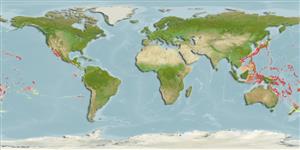>
Eupercaria/misc (Various families in series Eupercaria) >
Emmelichthyidae (Rovers)
Etymology: Emmelichthys: Greek, emmelyes, -es, -es = harmonious + Greek, ichthys = fish + Greek,ops = appearance (Ref. 45335).
More on authors: Heemstra & Randall.
Environment: milieu / climate zone / depth range / distribution range
Ökologie
seewasser benthopelagisch; tiefenbereich 180 - 428 m (Ref. 5515). Temperate
Western Central Pacific : Pacific coast of southern Japan, the northern part of the Kyushu-Palau Ridge, Hawaiian Islands, and Australia. Reported from Malaysia (Ref. 5756).
Size / Gewicht / Alter
Maturity: Lm ? range ? - ? cm
Max length : 30.0 cm SL Männchen/unbestimmt; (Ref. 559)
Found on the continental shelf (Ref. 75154).
Life cycle and mating behavior
Maturities | Fortpflanzung | Spawnings | Egg(s) | Fecundities | Larven
Masuda, H., K. Amaoka, C. Araga, T. Uyeno and T. Yoshino, 1984. The fishes of the Japanese Archipelago. Vol. 1. Tokai University Press, Tokyo, Japan. 437 p. (text). (Ref. 559)
IUCN Rote Liste Status (Ref. 130435)
Bedrohung für Menschen
Harmless
Nutzung durch Menschen
Fischereien: kommerziell
Tools
Zusatzinformationen
Download XML
Internet Quellen
Estimates based on models
Preferred temperature (Ref.
123201): 1.9 - 19.2, mean 13.5 °C (based on 111 cells).
Phylogenetic diversity index (Ref.
82804): PD
50 = 0.5156 [Uniqueness, from 0.5 = low to 2.0 = high].
Bayesian length-weight: a=0.01698 (0.00644 - 0.04481), b=2.99 (2.77 - 3.21), in cm total length, based on LWR estimates for this (Sub)family-body shape (Ref.
93245).
Trophic level (Ref.
69278): 3.4 ±0.45 se; based on food items.
Widerstandsfähigkeit (Ref.
120179): mittel, Verdopplung der Population dauert 1,4 - 4,4 Jahre. (Assuming tmax > 3).
Fishing Vulnerability (Ref.
59153): Low to moderate vulnerability (27 of 100).
